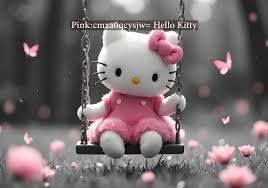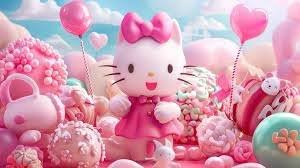pink:cmxa0qcysjw= hello kitty is more than just a character — she’s a cultural phenomenon. From her humble beginnings in Japan to becoming a global icon, Hello Kitty has touched the hearts of millions worldwide. Known for her signature pink bow and adorable face, Hello Kitty is beloved by children and adults alike. Whether you’ve grown up with Hello Kitty or are new to her world, it’s impossible to ignore the charm and impact she has on pop culture.
In this article, we’ll take a deep dive into the pink-tinted universe of Hello Kitty. We’ll explore her origins, how she became a cultural icon, and her influence across various industries. This exploration will give you a comprehensive understanding pink:cmxa0qcysjw= hello kitty Hello Kitty’s history, her rise to fame, and why she continues to be relevant in today’s fast-paced world.
A Look Back at Hello Kitty’s Origins: Where It All Began
Hello Kitty was born in 1974 when Japanese designer Yuko Shimizu created her for Sanrio, a company famous for its cute and playful products. At the time, Sanrio was looking to expand its brand and connect with a younger audience, and Hello Kitty was the perfect face for that venture. Originally designed to appeal to the kawaii (cute) culture in Japan, her cute, minimalistic design quickly caught on.
What made Hello Kitty stand out pink:cmxa0qcysjw= hello kitty was her simple yet captivating appearance. With a round face, button nose, and her iconic red bow, she represented innocence and playfulness. Her first appearance was on a coin purse, and from that moment, her image started spreading to various other products, from stationery to lunch boxes. The character was given a full backstory as well: she lives in London with her family and loves making friends, which made her even more relatable to children worldwide.
Despite her humble beginnings, Hello Kitty’s fame skyrocketed in Japan and soon crossed borders into the United States and other parts of pink:cmxa0qcysjw= hello kitty the world. By the late 1970s, she was already a household name. What many might not know is that Hello Kitty was initially targeted at young girls, but her fan base quickly expanded to include teenagers and adults, proving her appeal transcended age groups.
The Global Phenomenon: How Hello Kitty Conquered the World

After Hello Kitty’s initial success in Japan, it didn’t take long before she became a global sensation. Her simple design and lack of a mouth allowed pink:cmxa0qcysjw= hello kitty her to appeal to people from different cultures, as she could be interpreted in a variety of ways. Whether you saw her as happy, thoughtful, or even sad, her blank expression left her emotions up to the viewer’s imagination. This universal appeal made it easy for Hello Kitty to gain international fans.
In the 1980s, Hello Kitty’s popularity in the United States began to surge, especially among young girls who were drawn to her cute and gentle appearance. This period also marked the start of celebrity endorsements for the brand. Hello Kitty was embraced by celebrities, musicians, and even fashion designers who wanted to associate themselves with her clean, wholesome image. This helped catapult her into Western pop culture.
What’s even more remarkable is how Hello Kitty transcended cultural boundaries. Whether it’s her products being sold in trendy fashion boutiques in New York City or on the shelves of convenience stores in Tokyo, she remains a unifying symbol pink:cmxa0qcysjw= hello kitty of cuteness. It didn’t matter where you were in the world, Hello Kitty had a place in people’s hearts, and the pink world she came from seemed boundless.
The Expansion Beyond Toys: Hello Kitty in Fashion and Lifestyle
As Hello Kitty’s fame grew, she transitioned from being a beloved character in children’s toys to becoming a major figure in fashion and lifestyle. By the 1990s, Hello Kitty had evolved into a brand that encompassed more than just cute backpacks and school supplies. She had begun to appear in high-end fashion items and designer collaborations, turning her into a symbol of nostalgia and chic minimalism.
One of the most memorable moments in Hello Kitty’s fashion history was when she collaborated with luxury brands like Gucci and Balenciaga. These partnerships made Hello Kitty a stylish statement, taking her out of the realm of childhood and pink:cmxa0qcysjw= hello kitty into the adult world of fashion. You could now see her on runway shows, incorporated into designer bags, clothing, and accessories. Hello Kitty was no longer just for kids—she had become a fashion icon.
In addition to fashion, Hello Kitty expanded into various lifestyle products. From home décor to kitchen appliances, Hello Kitty-themed items were everywhere. Fans could now integrate her into their daily lives, with everything from Hello Kitty toasters pink:cmxa0qcysjw= hello kitty to bedding sets. The brand’s versatility allowed it to remain relevant, as there was something for everyone in Hello Kitty’s expanding product lineup.
Hello Kitty’s Influence in Entertainment and Media
Hello Kitty has also made her mark in the entertainment industry. From TV shows to movies and even video games, Hello Kitty has done it all. Her first TV appearance came in the 1980s with an animated series that aired both in Japan and the United States. The show, like Hello Kitty herself, was a massive hit and further solidified her place in the hearts of fans.
Over the years, Hello Kitty has starred in several animated series, movies, and video games, further cementing her legacy in the world of pink:cmxa0qcysjw= hello kitty entertainment. One of the most popular games is “Hello Kitty Online,” a social MMORPG (Massively Multiplayer Online Role-Playing Game) that allows fans to explore the Hello Kitty universe, interact with other players, and engage in various fun activities.
Her presence in media didn’t stop at animated features. Hello Kitty has appeared in countless manga, comic books, and children’s stories. As a character, she’s become a recognizable figure not only in animated form but also in literature. The Hello Kitty empire expanded to cover all forms of media, ensuring that her fans could engage with her across different platforms.
Hello Kitty and Her Impact on Pop Culture
It’s hard to talk about Hello Kitty without mentioning her massive influence on global pop culture. What started as a cute little character on a pink:cmxa0qcysjw= hello kitty coin purse turned into an entire lifestyle pink:cmxa0qcysjw= hello kitty brand. In the world of social media, fashion, and celebrity culture, Hello Kitty has left an undeniable mark. Celebrities like Lady Gaga and Mariah Carey have openly expressed their love for Hello Kitty, further pushing her into mainstream culture.
Hello Kitty’s collaborations with high-profile designers, makeup brands, and even airlines have all contributed to her long-lasting presence. Who can forget the Hello Kitty-branded airplane by EVA Air? It was one of the most creative partnerships, turning an everyday form of travel into a whimsical and fun experience for passengers.
She’s also had a strong presence at pop culture conventions and events. Hello Kitty-themed cafes, pop-up shops, and even pink:cmxa0qcysjw= hello kitty amusement parks have become popular tourist attractions. From exclusive Hello Kitty merchandise to elaborate live events, the brand’s engagement with its fanbase has ensured that it remains a relevant and exciting figure in the modern world.
The Cultural Significance of Hello Kitty’s Pink Color Scheme
One of Hello Kitty’s defining features is her connection to the color pink. Her bow, most often pink or red, is a central element of her design. But why pink? The color pink has long been associated with femininity, innocence, and playfulness—all attributes that Hello Kitty embodies. From a marketing perspective, pink has been an effective tool in reaching her target audience, which originally consisted of young girls.
However, over time, pink took on a broader cultural meaning. In the Hello Kitty world, pink isn’t just a color; it’s a representation of a pink:cmxa0qcysjw= hello kitty particular lifestyle—one that values kindness, positivity, and fun. As a result, pink has become synonymous with the Hello Kitty brand, appearing not only in her products but also in collaborations and marketing materials. This color scheme makes her instantly recognizable, and it’s a big part of what keeps her brand cohesive and strong.
Pink has been a staple in Hello Kitty’s brand identity, and it’s helped her stand out in a crowded marketplace. Even as trends pink:cmxa0qcysjw= hello kitty come and go, Hello Kitty’s association with pink has remained constant, symbolizing the brand’s commitment to cuteness and positivity.
The Evolution of Hello Kitty’s Design Over the Years
Hello Kitty’s design has remained relatively consistent over the years, but that doesn’t mean she hasn’t evolved. While her core look—a round face, no mouth, and that signature bow—remains the same, there have been subtle updates to keep pink:cmxa0qcysjw= hello kitty her fresh and relevant to new generations.
In recent years, Hello Kitty has been seen in more modern and versatile styles. For example, in her collaborations with fashion brands, Hello Kitty has been reimagined in more mature, chic designs, while still maintaining her essence. In animated features and video games, Hello Kitty has been depicted with a bit more detail, giving her a more contemporary look without losing her original charm.
These design updates have been essential in keeping Hello Kitty relevant. In an era where brands must constantly reinvent themselves, pink:cmxa0qcysjw= hello kitty Hello Kitty has managed to do so without losing her core identity, which is an impressive feat.
Hello Kitty’s Role in Charities and Social Causes
Beyond her commercial success, Hello Kitty has also made a significant impact on charitable initiatives and social causes. Sanrio, the company behind Hello Kitty, has used the character’s popularity to promote numerous charitable causes. For instance, Hello Kitty has been involved in campaigns promoting breast cancer awareness, children’s rights, and disaster relief efforts.
One of the most heartwarming aspects of Hello Kitty’s involvement in social causes is how she brings joy and hope to people in need. pink:cmxa0qcysjw= hello kitty Hospitals, schools, and various non-profit organizations have partnered with Sanrio to use Hello Kitty as a symbol of kindness and support. This has further endeared her to fans, showing that she’s not just a commercial product but also a force for good.
It’s not uncommon to see Hello Kitty on merchandise where a portion of the profits go to charity. Through these initiatives,
